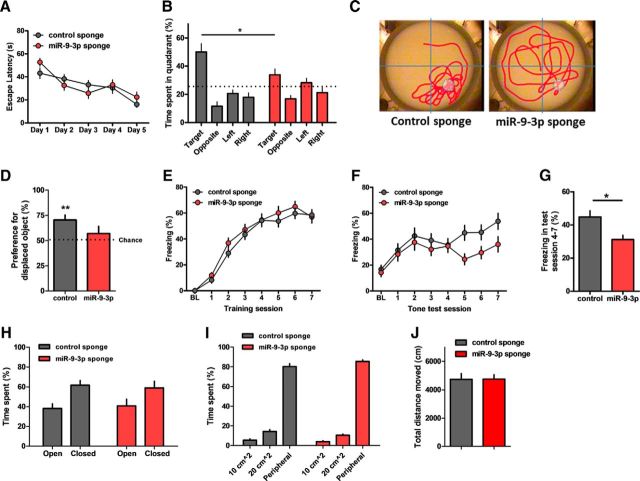Figure 4.
Inhibition of miR-9-3p activity impairs hippocampus-dependent memories. A–C, AAV-miR-9-3p sponge-expressing mice showed impaired spatial memory in the Morris water maze test (n = 9, AAV-control sponge; n = 10, AAV-miR-9-3p sponge). Escape latencies to the platform were similar in control and miR-9-3p sponge groups (repeated-measures 2-way ANOVA, the effect of sponge, F(1,68) = 0.15, p = 0.7062) (A). Probe test examining time spent in the target quadrant on day 6 showed significant spatial memory deficits in miR-9-3p sponge group (2-way ANOVA, sponge × quadrant, F(3,68) = 4.44, p = 0.0066; Bonferroni's post tests, *p < 0.05) (B). C, Representative images showing the swimming traces of mice during the probe trial. Dashed circle indicates the location of removed platform. D, Object location memory was significantly impaired in the miR-9-3p sponge group (n = 8, AAV-control sponge; n = 9, AAV-miR-9-3p sponge, 1-sample paired t test, **p < 0.01). The percentage preference for the displaced objects in the testing session is reported and the dotted line indicates chance (50%) preference. E–G, Trace fear conditioning was impaired in the miR-9-3p sponge group (n = 20, AAV-control sponge; n = 19, AAV-miR-9-3p sponge). The average freezing duration during training sessions was similar in control and miR-9-3p sponge groups (repeated-measures 2-way ANOVA, sponge × day, F(7,259) = 0.72, p = 0.6560) (E). Average freezing duration during testing sessions (repeated-measures 2-way ANOVA, sponge × day, F(7,259) = 2.02, p = 0.0526) (F). Average freezing duration during testing sessions 4–7 (unpaired 2-tailed t test, *p < 0.05) (G). H–J, Basal anxiety level and locomotor activity were intact in both AAV-sponge groups. The elevated zero maze test (n = 10, control sponge; n = 11, miR-9-3p sponge) (H). Open-field test (n = 10, control sponge, n = 11, miR-9-3p sponge) (I, J). Data are mean ± SEM.

